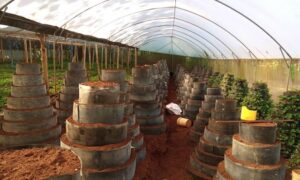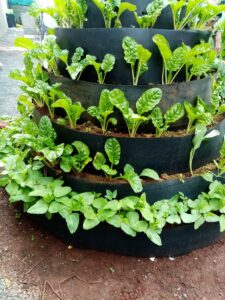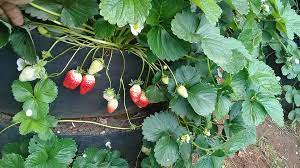Multi-Storey Gardens In Kenya
Grekkon Limited’s climate smart agriculture multi-storey gardens in Kenya are a vertical farming system popular with urban vegetable farmers. Growing herbs on a multi-storey garden in Kenya is now a common practice in limited spaces in densely populated locations. They are defined as climate smart agriculture because they conserve land and water

Multi-storey cropping in a greenhouse
What is a multi-storey garden?
It is a vertical farming method that limited space to create gardens stacked on each other. These vegetable crops (most common for kitchen gardens) provide a fresh supply of vegetables for subsistence or commercial use. Commonly grown crops are;
- Vegetables; kales, spinach, strawberry, coriander, carrot, garlic, leeks, black nightshade, amaranth
- Herbs and spices; rosemary, lemon grass, citronella, and mint
- Fruits; strawberry
A grower will choose to have the multi-storey farming system out in the open, or enclosed in a greenhouse or shade house. This multi-storey cropping is determined by the crop grown, or other factors such as crop destruction by pests or disturbance from pets. A grower will choose to have a shade net or dam liner as the supporting basis of this pyramid farming in Kenya. In this article, we look at the dam liner option

Spinach growing in on a kitchen multi-storey garden made from dam liner material
Our multi-storey garden price is Kes 2,500 a unit for the dam liner material type. This multi-storey garden cost covers all material and labor
How do you make multi-storey gardens in Kenya?
Key attributes of the dam liner material type garden
- Layers. It has 6 layers including the base
- Circumference. The base layer has a 6M circumference
- Layer reduction by height. Each layer is a meter less in circumference as it rises
- Height. Each layer has a height of 0.2M / 20cm
- Material. 0.75mm or 1mm thick HDPE dam liner to hold the soil together. The dam liner is bolted or welded at the joint

Strawberry growing on a multi-storey garden
To reduce soil compaction, and improve soil aeration, we mix soil with manure at a ratio of 2:1. On a space of 2M x 2M, a multi-storey garden will hold 180 to 250 plants. Compare this with a sack/ shade net supported garden that has 100-150 plants. And again with conventional ground farming that has 30-60 plants over the same area. All calculations factor in the walking path
Multi-storey garden materials
- dam liner
- joining clips
- soil
- fertiliser
How to irrigate multi-storey gardens in Kenya
Pre-perforated rip lines or button drippers irrigate these crops. Frequency of irrigation is twice or thrice weekly according to the prevailing weather
Multi-storey gardens in Kenya
FAQs
1. How to prepare a multi storey garden?
As described under the heading How do you make multi-storey gardens in Kenya? above
2. What is the size of a multi-storey garden?
6 square feet
3. What are the advantages of a multi-storey garden?
- It is easy to assemble, and maintain
- It saves on land and water
- They are done over small spaces
- You can grow many typesof vegetable crops on it
4. What are the disdavantages of a multi-storey garden?
- It takes time to design and make
- It requires training to make for the first time
- Expensive to undertake on a large scale. Ideal for small spaces
